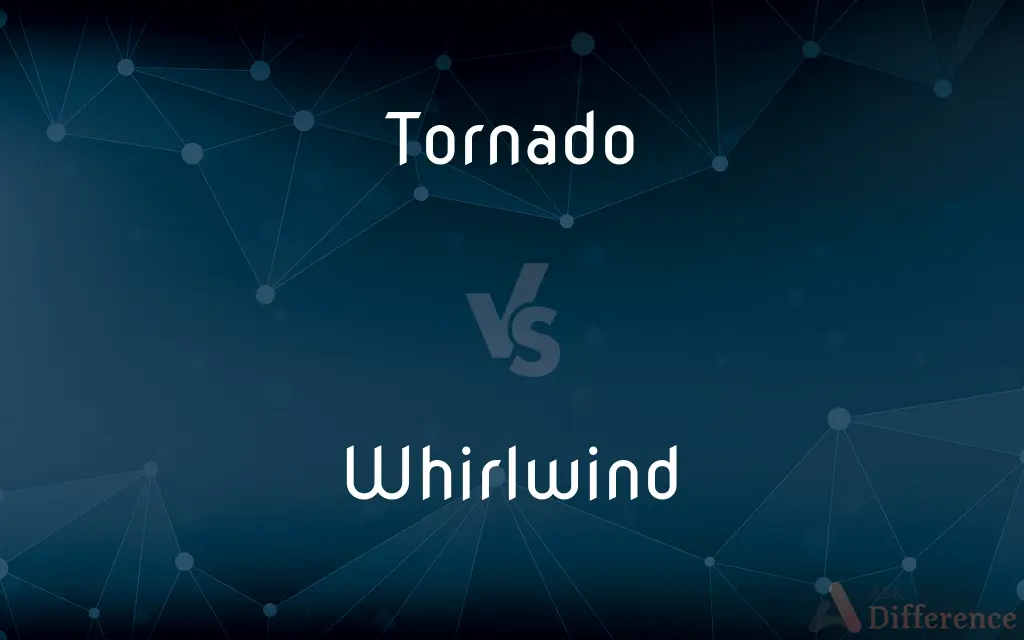Tornado vs. Whirlwind — What's the Difference?
Edited by Tayyaba Rehman — By Fiza Rafique — Updated on October 27, 2023
Tornado is a violent windstorm characterized by a twisting, funnel-shaped cloud; Whirlwind is a small rotating wind, not as intense as a tornado.

Difference Between Tornado and Whirlwind
Table of Contents
ADVERTISEMENT
Key Differences
Tornado and Whirlwind are both wind phenomena, but they differ significantly in scale and intensity. A tornado is a powerful, destructive vortex of violently rotating winds, typically associated with severe thunderstorms. In contrast, a whirlwind is a more general term referring to any rotating wind, often less intense.
Tornado is known for its distinct funnel shape and its ability to cause massive destruction over a specific path. This path can range from a few yards to several miles. Whirlwind, on the other hand, usually doesn't have such a pronounced shape or destructive capacity and can be seen in various settings, even deserts as dust devils.
The formation of a Tornado often involves a combination of specific meteorological conditions, including supercell thunderstorms. Whirlwind, conversely, can form under less specific conditions and can be relatively short-lived, sometimes lasting only a few minutes.
While both Tornado and Whirlwind are captivating to observe, the former poses a significant threat to life and property. Tornadoes can uproot trees, destroy buildings, and hurl objects at deadly speeds. Whirlwinds, while they can be unsettling, generally do not cause the same level of damage.
It's essential to differentiate between a Tornado and a Whirlwind in terms of safety. While tornadoes necessitate immediate protective actions like seeking shelter, whirlwinds, being less intense, might not require the same level of urgency, unless they are large or are causing visibility issues.
ADVERTISEMENT
Comparison Chart
Intensity
Highly intense, destructive
Generally less intense
Formation
Associated with severe thunderstorms
Forms under various conditions
Shape & Appearance
Distinct funnel shape
Less defined shape
Duration & Path
Can last for hours and have a specific path
Often short-lived
Associated Dangers
Significant threat to life and property
Usually minor or no damage
Compare with Definitions
Tornado
A windstorm capable of immense destruction.
Homes were leveled by the powerful tornado.
Whirlwind
A brief, intense wind event.
The picnic was interrupted by a sudden whirlwind.
Tornado
A meteorological phenomenon with a twisting vortex.
Meteorologists issued a tornado warning for the county.
Whirlwind
A vortex of wind, often seen as a dust devil.
A whirlwind formed in the desert, swirling sand around.
Tornado
A violent rotating column of air.
The tornado devastated the entire town.
Whirlwind
A rapid, rotating wind phenomenon.
Children laughed as the whirlwind spun leaves around them.
Tornado
A funnel-shaped cloud associated with thunderstorms.
People took cover when they saw the tornado approaching.
Whirlwind
A small rotating wind.
A whirlwind picked up leaves and scattered them.
Tornado
A cyclonic storm with intense rotational winds.
The tornado's path was evident from the damage left behind.
Whirlwind
A spiraling gust of wind.
The whirlwind danced across the open field.
Tornado
A tornado is a violently rotating column of air that is in contact with both the surface of the Earth and a cumulonimbus cloud or, in rare cases, the base of a cumulus cloud. The windstorm is often referred to as a twister, whirlwind or cyclone, although the word cyclone is used in meteorology to name a weather system with a low-pressure area in the center around which, from an observer looking down toward the surface of the earth, winds blow counterclockwise in the Northern Hemisphere and clockwise in the Southern.
Whirlwind
A whirlwind is a weather phenomenon in which a vortex of wind (a vertically oriented rotating column of air) forms due to instabilities and turbulence created by heating and flow (current) gradients. Whirlwinds occur all over the world and in any season.
Tornado
A violently rotating column of air extending from a cumulonimbus cloud to the ground, ranging in width from a few meters to more than a kilometer, with destructive winds up to 510 kilometers (316 miles) per hour or higher. Tornadoes are typically associated with a funnel cloud pendant from a storm's wall cloud, often extending to the bottom of the tornado.
Whirlwind
A rapidly rotating, generally vertical column of air, such as a tornado, dust devil, or waterspout.
Tornado
A violent thunderstorm in western Africa or nearby Atlantic waters.
Whirlwind
A tumultuous, confused rush.
Tornado
A whirlwind or hurricane.
Whirlwind
A destructive force or thing.
Tornado
(meteorology) A violent windstorm characterized by a mobile, twisting, funnel-shaped cloud.
A tornado is a rotating column of air.
Whirlwind
Tumultuous or rapid
A whirlwind political campaign.
Tornado
A violent whirling wind; specifically (Meteorol.), a tempest distinguished by a rapid whirling and slow progressive motion, usually accompaned with severe thunder, lightning, and torrents of rain, and commonly of short duration and small breadth; a small cyclone.
Whirlwind
A violent windstorm of limited extent, as the tornado, characterized by an inward spiral motion of the air with an upward current in the center; a vortex of air. It usually has a rapid progressive motion.
Tornado
A localized and violently destructive windstorm occurring over land characterized by a funnel-shaped cloud extending toward the ground
Whirlwind
(figuratively) A person or body of objects or events sweeping violently onward.
Once he got that new scooter he turned into a whirlwind and damaged all the flowers.
The weeks leading up to the convention were a whirlwind of preparation and hurried activity.
Tornado
A purified and potent form of cocaine that is smoked rather than snorted
Whirlwind
Rapid and minimal: a whirlwind tour, a whirlwind romance.
Whirlwind
A violent windstorm of limited extent, as the tornado, characterized by an inward spiral motion of the air with an upward current in the center; a vortex of air. It usually has a rapid progressive motion.
The swift dark whirlwind that uproots the woods.And drowns the villages.
Whirlwind
Fig.: A body of objects sweeping violently onward.
Whirlwind
A more or less vertical column of air whirling around itself as it moves over the surface of the Earth
Common Curiosities
What's the main difference between Tornado and Whirlwind?
Tornadoes are intense, destructive windstorms, while whirlwinds are generally smaller, less intense rotating winds.
Can whirlwinds be dangerous?
Generally, whirlwinds are less dangerous than tornadoes, but large ones can pose threats, especially to visibility.
Are tornadoes always associated with thunderstorms?
Most tornadoes form from severe thunderstorms, especially supercells, but there are exceptions.
Is a water spout a type of Tornado or Whirlwind?
A waterspout is essentially a tornado over water, but it can form under less severe conditions than typical tornadoes.
How can I distinguish a Tornado from a Whirlwind?
Tornadoes have a distinct funnel shape and are associated with severe weather, while whirlwinds are generally smaller and less defined.
How long do whirlwinds usually last?
Whirlwinds can be short-lived, lasting from a few seconds to several minutes.
Do whirlwinds always pick up debris?
Not always, but they can lift light debris or dust, especially in desert settings as dust devils.
Are whirlwinds always visible?
Not always. Their visibility often depends on the debris or dust they pick up.
How are tornadoes rated?
In the U.S., tornadoes are rated using the Enhanced Fujita scale based on the damage they cause.
Can tornadoes occur outside of the U.S.?
Yes, tornadoes can and do occur in many parts of the world.
Can whirlwinds form in urban areas?
Yes, whirlwinds can form in various settings, including urban areas.
Do whirlwinds have a rating system like tornadoes?
No, whirlwinds don't have a standardized rating system like tornadoes.
Are Tornado warnings common?
In areas prone to tornadoes, such as Tornado Alley in the U.S., warnings can be frequent during storm seasons.
Is every rotating wind a Tornado?
No, not every rotating wind is a tornado. Tornadoes are a specific type of intense rotational windstorm.
Which is more predictable, a Tornado or a Whirlwind?
Tornadoes, due to their association with specific storm conditions, are more predictable than whirlwinds.
Share Your Discovery

Previous Comparison
Farthing vs. Shilling
Next Comparison
Abide vs. BideAuthor Spotlight
Written by
Fiza RafiqueFiza Rafique is a skilled content writer at AskDifference.com, where she meticulously refines and enhances written pieces. Drawing from her vast editorial expertise, Fiza ensures clarity, accuracy, and precision in every article. Passionate about language, she continually seeks to elevate the quality of content for readers worldwide.
Edited by
Tayyaba RehmanTayyaba Rehman is a distinguished writer, currently serving as a primary contributor to askdifference.com. As a researcher in semantics and etymology, Tayyaba's passion for the complexity of languages and their distinctions has found a perfect home on the platform. Tayyaba delves into the intricacies of language, distinguishing between commonly confused words and phrases, thereby providing clarity for readers worldwide.














































